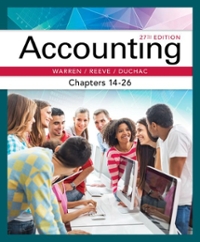Question
Read and complete the self-graded questions for ch7, 8, and 12 at PoA . The primary reading material source ishttp://www.principlesofaccounting.com/ B. Review your SEC 10-K
Read and complete the self-graded questions for ch7, 8, and 12 at PoA.
The primary reading material source ishttp://www.principlesofaccounting.com/
B. Review your SEC 10-K company's balance sheet (statement of position).
https://www.sec.gov/ix?doc=/Archives/edgar/data/732712/000073271221000012/vz-20201231.htm#i945fb9a9a3a64a8a80228fcfb91db25e_1956
Your SEC 10-K company communicates their philosophy and financing strategy on the balance sheet through reporting of assets and liabilities.First, what is Working Capital?It is calculated as:
Current Assets - Current Liabilities = Working Capital
Working capital (WC) may be negative if current liabilities (CL) exceed current assets (CA).If this occurs, what does this indicate about the corporation's financial position?Is this a cause for concern?How does your SEC 10-K company address this issue?Do they discuss strategy for overcoming a negative working capital?
The basic accounting equation is:Assets - Liabilities = Owners' Equity.This basic equation is illustrated by reporting assets, liabilities and owner's equity on the balance sheet. If owner's equity is positive, this is a favorable position. For some companies, especially if they recently recapitalized with debt, there may be negative equity.Discuss your corporation's financial position reported on the balance sheet.
Consider the classified balance sheet. What is a classified balance sheet?How is a classified balance sheet different from a more traditional balance sheet format that lists all assets and liabilities as one total.What is the benefit of creating subtotals within assets and within liabilities to separate current from non-current?
Provide a summary of the accounting concepts learned through the readings and practice quizzes for this week.Demonstrate your understanding of the week's concepts.The more detailed your write-up documenting your understanding the higher it will be graded.(See Rubric for details.)
After addressing the above topics, additional topics you can incorporate into your weekly homework assignment:
- Why do companies need to value their accounts receivable at the end of each accounting period?
- Discuss the differences between the inventory accounting methods (LIFO, FIFO, Weighted Average, Specific Identification).Do these inventory methods reflect the actual flow of inventory?
- What are some of the current liabilities you learned about in this week's readings.
- What topic(s) gave you trouble this week (if any)?/What topic(s) do you feel you were able to grasp?Post questions in the homework discussion thread!
The most important aspect of this write-up is to document a understanding of the week's concepts!
Verizon Communications Inc. 2020 Form 10-K
https://www.sec.gov/ix?doc=/Archives/edgar/data/732712/000073271221000012/vz-20201231.htm#i945fb9a9a3a64a8a80228fcfb91db25e_1956
Step by Step Solution
There are 3 Steps involved in it
Step: 1

Get Instant Access to Expert-Tailored Solutions
See step-by-step solutions with expert insights and AI powered tools for academic success
Step: 2

Step: 3

Ace Your Homework with AI
Get the answers you need in no time with our AI-driven, step-by-step assistance
Get Started


